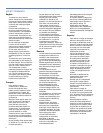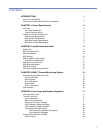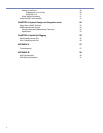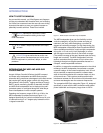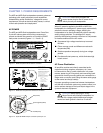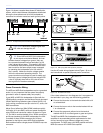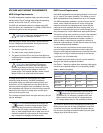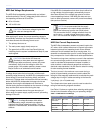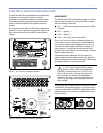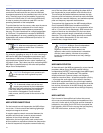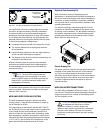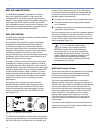
4
CHAPTER 1
5
CHAPTER 1
VOLTAGE AND CURRENT REQUIREMENTS
M2D Voltage Requirements
The M2D loudspeaker operates safely and without audio
discontinuity if the AC voltage stays within the operating
window of 90 to 265 volts AC, at 50 to 60 Hz.
The M2D can withstand continuous voltages up to 265
Volts and allows any combination of voltage to GND (that is
neutral-line-ground or line-line-ground).
CAUTION: Continuous voltages higher than
265 volts may damage your M2D.
After applying AC power, the system is muted while the
circuitry charges up and stabilizes. During the next two
seconds the following events occur:
1. The power supply fan turns on.
2. The main power supply slowly ramps on.
3. The green On/Temp LED on the User Panel lights up,
indicating that the system is enabled and ready to pass
audio signals.
CAUTION: If the On/Temp LED does not
illuminate or the system does not respond
to audio input after ten seconds, remove AC power
immediately. Verify that the voltage is within the
proper range. If the problem persists, please contact
Meyer Sound or an authorized service center.
If voltage drops below the low boundary of its safe
operating range (brownout), the M2D loudspeaker
uses stored energy to continue functioning briey, and
shuts down only if voltage does not rise above the low
boundary before storage circuits are depleted. How long
the loudspeaker will continue to function during brownout
depends on the amount of voltage drop and the audio
source level during the drop.
If the voltage increases above the upper boundary, the unit
may be damaged.
NOTE: It is recommended that the supply be
operated in its rated voltage window at least
a few volts away from the turn on/off points. This
ensures that AC voltage variations from the service
entry, or peak voltage drops due to cable runs, do not
cause the amplier to cycle on and off. It also keeps
high voltage from damaging the power supply.
M2D Current Requirements
Each M2D loudspeaker requires approximately 3 A rms max
at 115 volts AC for proper operation. This allows up to ve
M2D loudspeaksers to be powered from one 15 A breaker.
The M2D loudspeaker presents a dynamic load to the AC
mains, which causes the amount of current to uctuate
between quiet and loud operating levels. Since different
cables and circuit breakers heat up at varying rates, it is
essential to understand the types of current ratings and how
they correspond to circuit breaker and cable specications.
The maximum long-term continuous current is the maximum
rms current during a period of at least ten seconds. It is
used to calculate the temperature increase in cables, in
order to select a cable size and gauge that conforms to
electrical code standards. It is also used to select the rating
for slow-reacting thermal breakers.
The burst current is the maximum rms current during a
period of approximately one second, used to select the
rating for most magnetic breakers and to calculate the peak
voltage drop in long AC cables according to the formula:
V pk (drop)= I pk x R (cable total).
The ultimate short-term peak current is used to select the
rating for fast-reacting magnetic breakers.
Use Table 1.1 below as a guide when selecting cable gauge
size and circuit breaker ratings for your operating voltage.
Table 1.1: M2D Current Ratings
Current Draw 115 V AC 230 V AC 100 V AC
Max. long-term
continuous
3.1 A rms 1.6 A rms 3.6 A rms
Burst current 3.2 A rms 1.6 A rms 3.7 A rms
Ultimate short-
term peak
5.8 A pk 2.9 A pk 6.7 A pk
Idle current 0.35 A rms 0.35 A rms 0.35 A rms
NOTE: For best performance, the AC cable
voltage drop should not exceed 10 volts, or
10 percent at 115 volts and 5 percent at 230 volts.
Make sure that even with the AC voltage drop the
AC voltage always stays in the operating windows.
The minimum electrical service amperage required by an
M2D system is the sum of each loudspeaker’s maximum
continuous rms current. An additional 30 percent above
the minimum amperage is recommended to prevent peak
voltage drops at the service entry.




